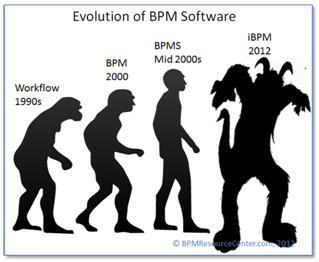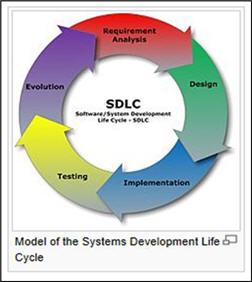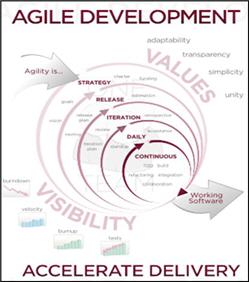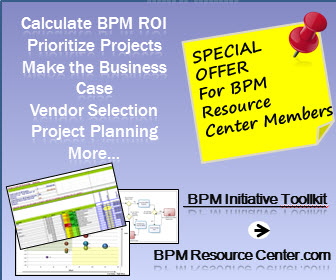
BPM can be applied to large and small organizations alike.
The goal - the improvement of business performance and agility by applying one or all of the following:
- A comprehensive, well understood and documented set of standardized processes – typically defined within a process framework to drive transparency and efficiency. aka BPM
- An approach to process improvement including an approach to measuring and monitoring day to day business processes for continuous improvement and efficiency. aka BPI/BPM
- Use of information technology/software including process modeling, process simulation, process repositories, workflow, integration, reporting and other technologies to facilitate bullets 1 and 2 as well as automate and further optimize processes. aka BPMS/SOA/BI
The following defines a few basic terms before we delve further.
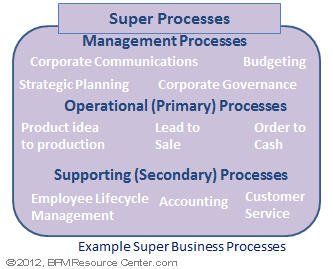
Definition of a Business Process
A business process can be anything from processing a customer order, to opening a new account, to on-boarding a new employee. It is the set of steps taken in our day to day work activities that is performed to accomplish a desired outcome.
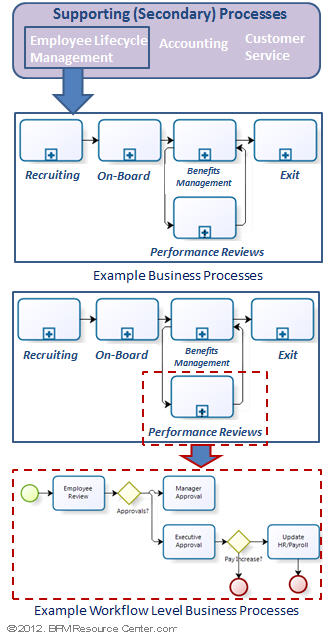
Types of Business Processes
There are different levels or types of business processes. Types of processes referred to here as 'Super Processes' (include management processes, operational processes and supporting processes).
Operational processes – also considered 'core value streams' or 'primary processes', are those processes that are central to the design, production and delivery of a company’s products and services. The top chart includes some examples of these super business processes. A key concept in BPM is to focus on optimizing the “value stream” or the processes that collectively deliver value to the customer.
Super processes can usually be broken down into high level business processes or groups. For example, if we look at the Employee Lifecycle Management super process in more detail, it can be unpacked into several business processes such as Recruiting, Employee On-boarding, Benefits Management, Performance Reviews and Employee Exit.
These high level business processes in turn can be broken down into workflow level processes which are the detailed activities and tasks performed to complete each process as depicted by the Performance Reviews workflow to the right. Understanding how day to day work activities ultimately roll-up to high level processes and super processes is fundamental to the establishment of metrics and the alignment of work activities to strategic goals and business objectives.
Learn more about industry standard process frameworks with defined process categories and breakdowns by visiting APQC.
Process Improvement
There are many workforce and business system inefficiencies today that can easily lead to to problems such as poor quality of service and resulting customer satisfaction, unnecessary costs, and employee morale issues. Often, you can directly tie these issues and problems to poor understanding, measurement and control of day-to-day work activities- (AKA business processes). So another major aspect of BPM is the better understanding of processes (through techniques such as mapping/documenting processes and workflows) and looking for waste and ways to streamline and improve processes.
The example on the right depicts a workflow level HR process and tries to show the relatively chaotic mechanisms that we are probably all too familiar with. When there is little formalization or concentration given to process improvement, everyone may know what the end goal is, but it may seem like it's handled differently every time. (When everyone talks about how 'broken' a process is, you probably have a good process candidate for BPM improvement initiative).
Using a variety of BPM methodologies and analysis techniques that we cover in the How To section, you probably have a very good shot at improving your business from the institution of the resultant improved process(es).
Process Automation
Some processes but not all, can also benefit from the use of BPMS Business Process Management Software) or other forms of technology. A combination of workflow automation, integration, monitoring and management tools, BPMS platforms can offer very significant benefits. They can automate workflow and orchestrate processes, reduce risk of errors, provide metrics and visibility into status; enforce deadlines; validate, properly route and synchronize data; reduce training costs and provide other benefits as well. These improvements can add up to a very serious positive impact on a business's bottom line.
The case for BPMS can be seductive, but the effort to implement these systems should be carefully considered. What might appear at first to be a simple process may in fact have so many 'hidden' exceptions that an automation effort becomes a much more extensive and expensive project than originally estimated.
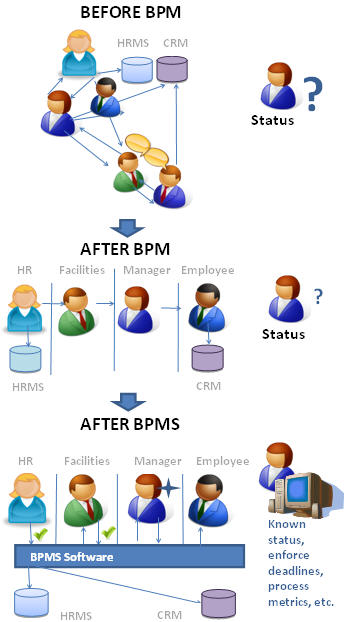
With some of these elements defined, let's get back to the question - what is bpm?
Business Process Management (BPM) is:
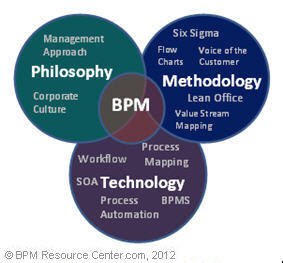
Ready for the simple, crisp definition? Don't be crestfallen, but BPM is one of those business acronyms that is used differently in different contexts.
A holistic perspective of BPM includes all three of the following notions:
- Ideally, BPM is a Management Approach/Philosophy led by a company's management team that places emphasis on understanding and optimizing business processes. By defining business processes, establishing measurements to track their performance in alignment with business goals, implementing improvements and monitoring processes, companies can not only innovate faster to meet changing market demands, they can deliver the best quality products and services in the fastest and most cost effective way to both internal and external customers. Change Management and Performance Management are key aspects of BPM.
- BPM can also refer to a Methodology for instituting a continuous process improvement lifecycle. Methodologies provide specific guidance in the form of phases, activities and techniques business teams can use to continuously improve a business process.
- Sometimes BPM refers to Technology that is used to help perform the activities of the methodology and/or enforce its execution. BPM software can help with mapping and documenting business processes to aid communication, analyzing them to identify inefficiencies, control them thru workflow, automate activities, monitor both business activities and performance as well as augment and enhance current computing systems to optimize workforce. We should note that there is no key underpinning technology that defines a system as 'BPM'. No matter whether its 'old school' software design or something that incorporates the latest social networking techniques, so long as it attempts to address the goals of BPM, it might be labeled BPM technology.
BPM Methods VS BPM Technology (BPMS)
Before you embark on any type of BPM journey, you should really understand the difference and benefits of both BPM and BPMS. They are two very distinct yet intersecting disciplines. The former focuses on technique, the later technology. Both are aimed at improving business performance and can be applied separately or in some combination. The fact that people often believe the terms are synonymous blurs concepts and terminology.
Often people enter into BPM from one perspective and entirely miss the benefits of the other – applying technology without method or method without technology. They yield the most significant results when used in combination. It's worth spending time to understand them both.

BPM Methodology & Philosophy
BPMS Technology

Business management led initiatives that aim to align business goals to business processes to aid in the achievement of those goals through:
- Measure,monitor and manage
processes on an ongoing basis
processes on an ongoing basis
- Continuously improving processes
- Organizing by process rather than
function
function
Adopting Methodologies (like Lean, Six Sigma or the BPM Lifecycle) that provide formalized approaches, phases and specific techniques to improve processes.
- Improvement of existing processes
- Re-engineering of processes
- Creating entirely new processes
Culture focused on process as a means to improve quality/value to customers.

BPA Tools
BPMS ('Suites')

Desktop based software for electronic process flow chart mapping/design and documentation to aid in process understanding and communication.
Cloud-based electronic process design tools with on-line centralized libraries and collaboration tools to aid in cross enterprise process understanding and communication, and centralization of information.
Other Process modeling and simulation software tools to aid in various organizational, business system and process design and analysis
BPM Suites include varying types of BPA tools to support the design and analysis phases of BPM methodologies
Workflow/Routing/Alerting/Electronic Forms/Documents Management and other similar components of these tools control and direct the flow of work between people, thereby streamlining work and enforcing business policies and procedures.
Integration/SOA orchestration components control the flow and use of existing business system logic and data and develop new "modular" software applications to support new processes and provide for greater future flexibility
Monitoring, Reporting tools/Report Dashboards – aid in providing visibility, tracking metrics and decision making.
The benefits of BPM are both qualitative and quantitative and there is not an industry segment that cannot benefit from BPM. Both top line and bottom line benefits have been proven time and time again- from increasing revenues by speeding time to market, improving customer service or improving product and service quality, to lowering costs through workforce and business systems optimization.
You can lean more about the benefits of BPM by reviewing the many case studies available in our database, viewing this video on the benefits of BPM or downloading this BPM Case Study Summary Report.
Below are 7 factors and related considerations for implementing BPM. Once you determine scope and goals, method(s) can be derived. Once you determine the method(s), then skills, tools, investments and sponsorship can be determined.
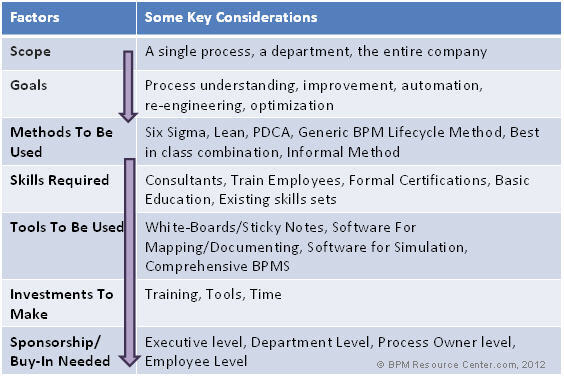
Read more on bpm implementation approaches under our how-to section.
Frequently Asked Questions
The next sections answer common questions asked about BPM and provides some short videos and references to articles that expand upon relevant concepts or terms.
Six Sigma and Lean are specific methods and techniques used for process improvement initiatives. These methods originated from streamlining manufacturing processes, but you can apply many of the principles of these methods to a business process. Lean (pioneered by Toyota) focuses on streamlining the flow of a process by looking for and eliminating non-value added activities and waste. The central promise is that if you kill off no-value activity, you can do things faster and more cost effectively.
Six Sigma (created by Motorola) is oriented on quality and defect reduction. A six sigma process is one in which 99.99966% of the products manufactured (items processed) are statistically expected to be nearly free of defects (3.4 defects per million). The emphasis in Six Sigma is to focus on the problem causing defects and correct them. “Lean Six Sigma” is the combination of both methods.
The BPM lifecycle is a generic process optimization methodology defined explicitly for business processes. It provides a high level approach from a phased perspective without prescribing specific techniques such as those found in Six Sigma or Lean.
BPM lifecycle does require, however, that some structured approach is used to 1) understand processes, 2) analyze them to determine opportunities for improvement, 3) implement the improvements, 4) measure the results and 5) revisit them for continuous improvement. Depending on how complex the process is, what problem(s) you are trying to solve, your company's skills, culture ,etc., you might embrace Six Sigma or Lean holisticly, or leverage some of the techniques from these methodologies and use that within your customized BPM lifecycle.
Learn more about specific BPM methods and methodologies
BPA is used to facilitate process understanding and process improvement. All BPM initiatives require that business processes are first well understood. They are then analyzed to find ways to better perform them. BPA tools and techniques help you capture process information, understand the current state of the process (as-is) and help to define a future state (to-be) through mapping and analysis techniques.
Depending on the focus of the improvement initiative, different modeling and analysis methods and tools might be used. For example, if a process is taking too long, value stream mapping might be used. If a process produces too many defects, techniques from Six Sigma may be more useful.
You can accomplish many BPA activities with simple tools like white boards, post it notes and a calculator. However, there are many BPA software tools available that might be helpful, especially for more complex processes. Some are stand alone tools, some are a subset of more comprehensive BPMS software system. * Learn more about process modeling and analysis.
In many organizations, day to day activities may be so ingrained and routine that it's not always clear what the exact steps are in a given process. Different members of the organization may not know what happens to an item once it leaves their hands. Official processes write-ups that you might find in the corporate operations or policy guide might not map what actually is being performed. Complicating all of this is the high probability that it may not be very clear at all what processes might yield the greatest improvement opportunities.
Process discovery can be as simple as gathering teams together (physically or virtually) and discussing and documenting (mapping out) how a particular process is performed. Through discussion and interviews with the people directly involved, you can usually discover the end to end steps of a process across teams, departments, divisions, etc. During this collaboration, you can also extract key metrics (volumes, costs and other measurements) that can help determine if making improvement investments will yield the results you seek to meet strategic goals. There are a number of BPMS (software) tools that that facilitate process discovery with group collaboration, data collection and documentation features.
Automated process discovery is done by mining existing information systems. By analyzing event and transaction logs for example, you can use the actual work being done (who did what, when, for how long). Today, technology tools have emerged that can read in data from various systems and present that information in flow diagrams, charts and in other ways to help us understand process steps, bottlenecks and more.
BPMN is a standard notation for describing a business process. It has a standard set of icons and was created so that there would be a common way to visually depict the flow of work and information. Today, most BPMS tools and many process modeling and analysis tools support this notation as a standard way to map out a procedural process flow. Go to BPMN aids section of the site to learn more.
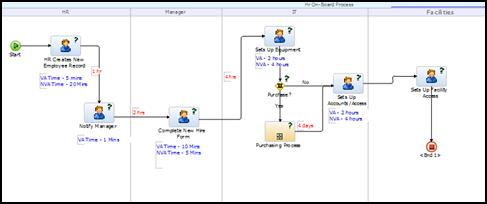
Wikipedia definition: Business Process Model and Notation (BPMN) is a graphical representation for specifying business processes in a business process model.
Value stream mapping, while originating in manufacturing, is now being applied to business processes. It is a particular way to visualize a process flow, and is especially useful when a physical product being produced. The aim is to identify value add and non-value add activities that you perform in a given business process with the ultimate goal of identifying opportunities to eliminate or reduce those non-value added activities and waste (wasted time, delays, rework, doing more that is necessary etc.). .
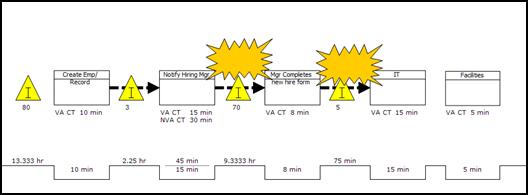
Wikipedia definition: Value Stream Mapping is a lean manufacturing technique used to analyze and design the flow of materials and information required to bring a product or service to a consumer.
BPMS (Business Process Management Software) is a collection of software tools that help facilitate a BPM initiative. Within a BPMS platform, there are tools to aid in all phases of the BPM lifecycle: Design, Modeling, Execution, Monitoring and Optimization.
For the Design and Modeling phase, BPM tools provide visual mapping and documenting processes which can help with understanding the current process state, and can then communicate that knowledge within an organization. Some offer additional analysis and simulation capabilities that can aid in analyzing processes for the purpose of identifying opportunities for improvement.
While you certainly can improve a process without automation, BPMS systems are also generally used for automating processes as part of the execution, monitoring and optimization phases. BPMS tools can be used to create entirely new applications, convert paper processes to paperless or augment, enhance or modernize existing business systems. They can extract, format and distribute information and route that information between systems and people in accordance with the business process steps and business policies and rules. This helps to enforce standard work procedures and timelines, as well as track work activities and metrics. BPMS systems include workflow, electronic forms, alerting features and user work portal (in-boxes, real-time monitors, reporting and dashboards). Most also include some type of business rules engine, system integration and service orchestration capabilities.
The scope of what is classified as and considered part of BPM tools has morphed and expanded over the years. It roots are in workflow and the ability to control and enforce the movement of documents and information.
However, as the market has evolved, BPM has morphed from BPM, to BPMS (suites) that included more capabilities around process analysis and service orchestration (web services based integration) to the BPM of 2013 being defined as iBPM (Intelligent BPM). Some critics say, with some justification, that the scope of what is now included under the umbrella of BPM is something of a monster. . We expect that over time, the better integration of these added components will tend to provide cleaner and more user friendly end user environments.
As you can see by the diagram below, the core components continue to expand as software vendors seek to provide comprehensive and complete capabilities in each core area and adapt to technology evolution. This is being handled through acquisition as well as through internal development efforts. The result is that the market now has offerings that range from just core components to the “whole enchilada”.
While the depth and complexity of these the larger platforms can be intimidating, we should expect to see that better integration of acquired components and more evolved user interface designs will tend to provide cleaner and more user friendly end user environments with less steep learning curves. To understand more on how to tackle using and investing in BPM software, review the guidance section of the site.
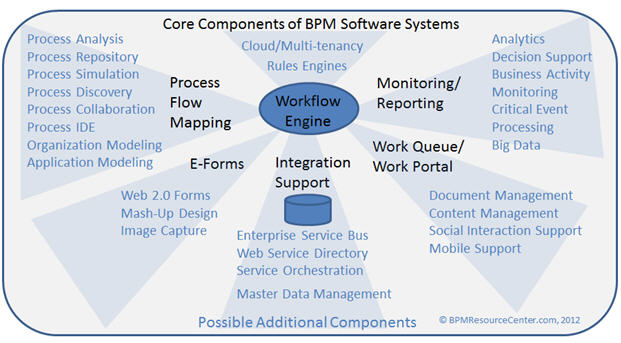
Business Process Management technology assumes that a process has a structured and repeatable set of steps. For example, let's assume that processing an expense report takes 5 specific steps. 1) The employee completes the expense claim form, 2) a manager approves it, 3) a senior manager approves it, 4) it is sent for payment where a check is cut and 5) the check is sent to the employee. While there may be variations – for example an expense might route to different approvers based on the total amount of the expense or the employees department, the number and type of possible paths and steps are still definable.
Dynamic BPM has emerged in order to tackle those situations where there are too many exceptions to document all the possible paths a process might take. In these cases, a person who currently has the work needs to make an on-the-spot decision as to how it should be routed. Dynamic BPM systems allow the user or manager to add steps to the process, at execution time, as might be needed for that particular piece of work. This is often found in processes like legal or insurance case management where a wide set of people may need to be provide input, approvals, comments, appeals or executive decisions on an ad hoc, case by case basis.
Agile BPM is rooted in the Agile software development lifecycle management methodology (SDLC). The basic concept is that for development of software, or in the case of using a BPMS to implement a process-centric application, the Agile SDLC approach is applied.
Traditional SDLC methods did everything in long and complete phases – gather all the requirements (and every possible use case for how the system will be used), design the entire system, and deliver the complete system to the users. Agile SDLC is an iterative approach where things are done in many smaller iterations in all phases. You define a subset of requirements, build it, test it and then do more. – keeping user involvement throughout. It relies on prototyping, tight communication in daily or weekly meetings to keep things moving and on track. Agile fosters more rapid, iterative development and is typically very beneficial to use when implementing a BPMS tool.
Wikipedia links: More information on Software Development Lifecycle and Agile Development
As web 2.0 emerged (the second major phase of the internet evolution), “Social” applications like Facebook, Twitter, Linked In and Wikipedia came into being.
Companies are beginning to use these social types of applications and models (sharing, posting, collaborating) for getting work done in the office by allowing employees to more easily collaborate. This could be as simple using a wiki to drive collaboration on the design (documentation) or as elaborate as incorporating social interactions like discussions, tweets, polls, trending metrics etc.to help facilitate work completion.
If, for example,you are routed a particular work item for a process that might require lots of co-worker input and advice, you could use your social connections and the network that you have amassed to help you get that particular job done. New business oriented social platforms like Yammer and Chatter (Facebook-like applications for business) are quickly emerging, so its likely that the trend will continue and accelerate.
BPM systems are either building their own social functionality into their platforms or are integrating to the major social networking applications.
Other concepts that are associated with Social BPM is the use of mobile computing, software as a service (Cloud based computing) and “big data” (applications that generate lots of data that is worthy of mining).
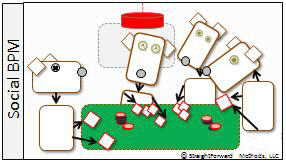
Learn more about Social BPM by reviewing the papers and articles below:
















